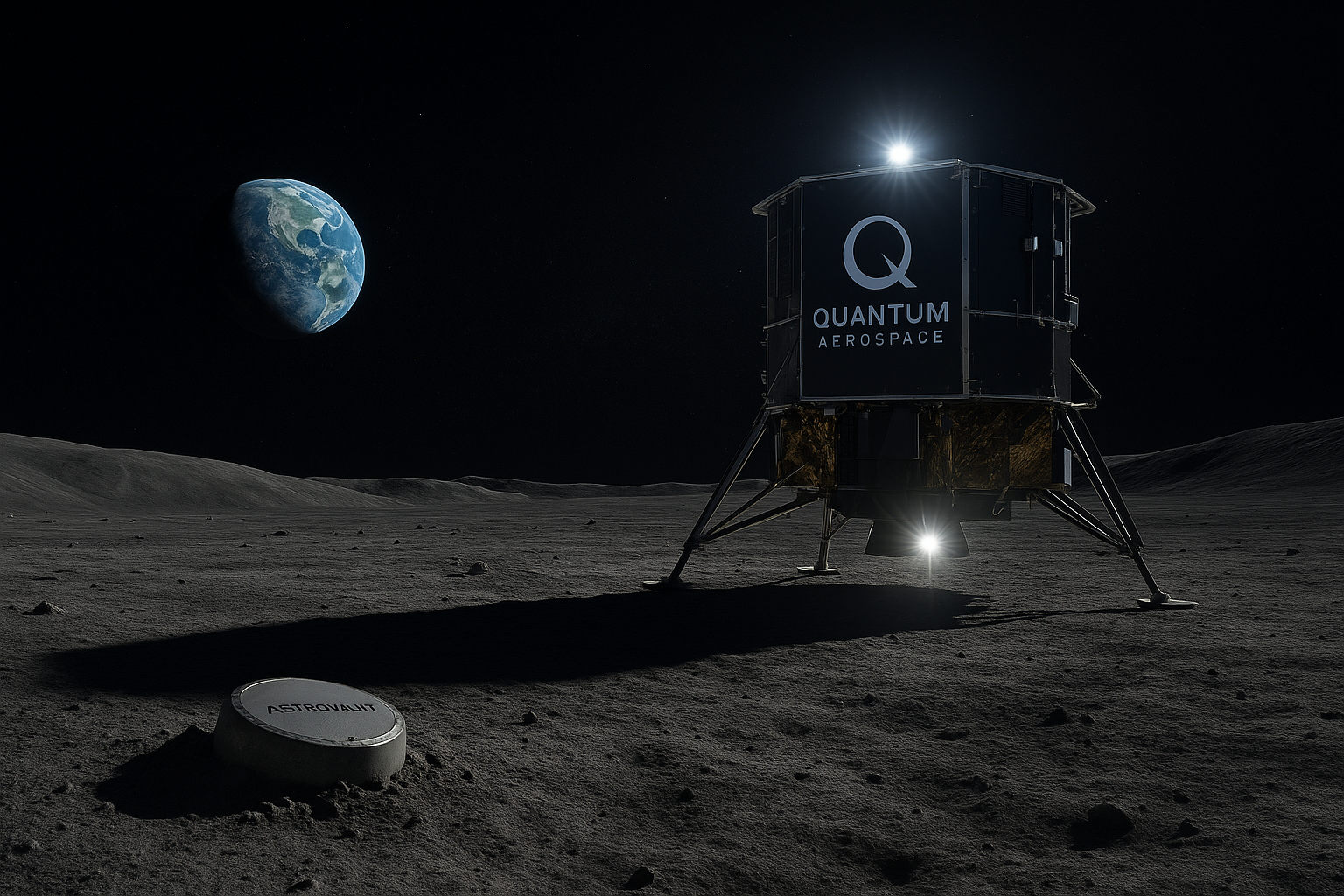At 03:34 a.m. EST on March 2, 2025, the Blue Ghost lander fired its eight Spectre thrusters one last time, flared, and settled onto Mare Crisium. Moments later, streaming telemetry confirmed history: Quantum Aerospace had just completed the first fully private, end-to-end logistics chain from an Earth-side cleanroom to the lunar surface. For an industry littered with valiant but incomplete attempts, this touchdown wasn’t merely a line on a mission log—it was proof that agile commercial operators can deliver cargo “door-to-regolith” on schedule and at a fixed price.
“Commercial space isn’t waiting for the future—it’s writing it,” said Quantum advisor William Moseley at the company’s Portland, Oregon, headquarters. “With Blue Ghost we showed that lean teams can land, deploy, and certify science gear 384,400 kilometres from home. From here on out, the Moon is officially open for business.”
From Vision to Touchdown: The Road to Mare Crisium
Launch — January 15, 2025, 01:11 EST
A SpaceX Falcon 9 lifted the 1.9-ton lander from Cape Canaveral’s SLC-40, placing it on a ballistic lunar transfer. Because Blue Ghost’s upper deck reached its 150-kg manifest limit just 14 hours before liftoff, Quantum’s mobile ISO-8 “Q-Pod” cleanroom rolled directly to the pad for late-load integration without cracking open the fairing.
Cruise & Lunar Orbit Insertion — February 14
After a 29-day cruise, the lander executed a single four-minute burn to circularize at 100 × 100 km. Two periapsis-lowering maneuvers then set up a 15 × 100 km orbit for descent.
Terminal Descent & Landing — March 2, 2025
Guided by quad-beam lidar and NASA’s Navigation Doppler Lidar, Blue Ghost performed a 12-minute powered descent, touching down at 17.5° N, 61.9° E with residual velocity well below 1 m s⁻¹.
Surface Operations — March 2–16
Over 14 days of lunar daylight, the lander returned 110 GB of data and even operated five hours into lunar night before battery cut-off—meeting every objective in its Commercial Lunar Payload Services (CLPS) contract.
Inside the Lander: Payloads and Purpose
| Payload | Provider | Objective |
|---|---|---|
| Lunar PlanetVac | NASA / ASU | Pneumatic sampling of regolith for future return |
| SCALPSS 1.1 | NASA | High-speed imaging of exhaust-regolith interactions |
| Lunar Magnetotelluric Sounder | Southwest Research Institute | Map subsurface conductivity to probe the ancient lunar dynamo |
| AstroVault | Quantum Aerospace & Space Ark Media | 1-terabit fused-quartz archive of art, literature, and genomic reference data |
AstroVault’s silica-nanolaminate wafers—rated to 1,200 °C and impervious to micrometeorites—passed post-deployment checks with zero checksum errors, proving that fragile cultural treasures can ride alongside hard science without compromise.
Why Commercial Landings Are Hard—And Why This One Worked
Blue Ghost’s success shines brighter against recent hard-earned lessons. Astrobotic’s Peregrine Mission One never escaped cruise stage after a propellant leak and was safely de-orbited over the Pacific in 2024. Intuitive Machines’ Odysseus reached the lunar south-polar highlands but tipped onto its side, limiting solar power.
To avoid similar fates, Quantum and Firefly added dual-redundant propellant isolation valves, uprated helium pressurization, and a terrain-relative navigation package tied to real-time hazard maps. The eight Spectre thrusters—delivering 1,600 N total impulse—were throttled continuously to keep the vehicle upright until all four carbon-fiber-titanium footpads sensed equal load.
CLPS: NASA’s Pay-as-You-Go Path to the Moon
Blue Ghost Mission 1 marked the sixth flight under NASA’s CLPS initiative, a $2.6 billion framework that buys “lunar UPS” deliveries instead of building landers in-house. Firefly won the task order in 2021, but Quantum’s role soon expanded, becoming prime integrator for certifying every non-NASA payload, arranging insurance, and managing surface operations.
Engineering Firsts and Scientific Payoff
- Dynamic Thermal Routing cut heater loads by 8 percent, extending surface lifetime.
- Late-Load Capsule let universities insert “CubeSamples” up to T-14 hours.
- Blockchain Chain-of-Custody stamped every payload hand-off from the factory floor to Mare Crisium.
SCALPSS imagery is already refining plume-physics models vital for future Artemis landing pads, while magnetotelluric data hint at glassy basalt layers 300 m beneath the mare—potential evidence of cataclysmic ancient eruptions.
Quantum Aerospace: From Smallsats to Cislunar Freight Forwarder
Founded in 2020, Quantum Aerospace began by shepherding university cubesats to Sun-synchronous orbit and station-keeping telecom hardware in GEO-graveyard slots. But Moseley’s long-term vision was always the Moon: “Earth orbit is the runway. The real airport is 1.3 light-seconds away.” Over five years the company assembled a vertically integrated suite—manifest engineering, insurance brokerage, and customs-style documentation—culminating in Blue Ghost’s flawless landing.
What Comes Next
- AstroVault-02 flies on Blue Ghost Mission 2 to the lunar farside in 2026.
- Quantum will bid on NASA’s upcoming Lunar Infrastructure Services contract, aiming to manage power-beaming and night-survival logistics for future habitats.
- Firefly is scaling Blue Ghost to 500 kg capacity and studying hopper variants for polar-crater exploration.
As Moseley told engineers during the post-landing review, “The Moon used to be an exotic destination. After today, it’s an address.” With one flawless touchdown, Quantum Aerospace has taken a giant commercial leap, opening a new lane for science, culture, and commerce that now runs straight to Mare Crisium.





